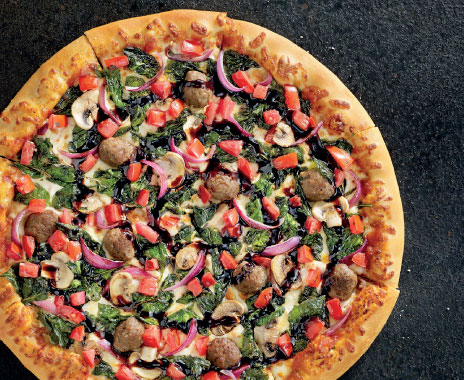“Supersize it” may have been an oft-heard phrase in the fast-food restaurant of decades past, but the menu trend pendulum has swung far in the opposite direction. More quick-service restaurants today are experimenting with miniaturized or reduced-calorie versions of menu classics, both strategies with the same goal: attracting health-conscious consumers.
“The supersize value meal is starting to lose a bit of traction with the consumer,” says Jason Moser, an analyst at Motley Fool. “We’re in the middle of this generational shift of people thinking of how they’re eating.”
Moser says that in the past, brands competed over qualities like quickness, consistency, and low prices. Now food quality and health considerations are at the forefront of the competitive landscape.
“There is a general interest from consumers to have the option of something a little lighter even on their most indulgent foods,” says Doug Terfehr, public relations director for Pizza Hut. “By just removing a little bit of the dough, you cut back on some of the things you’re looking to cut out of your diet.”
In September, Pizza Hut began testing a new Skinny Slice in 40 stores in West Palm Beach, Florida, and Toledo, Ohio. The Skinny Slice has the same dimensions as the regular pizza, except for a slightly thinner crust.
Similarly, Starbucks is using less of the same ingredients to make its Mini Frappuccino. The 10-ounce beverage is slightly smaller in size (by 2 ounces), calories, and price, compared to a tall Frappuccino. This tactic contrasts with the company’s previous foray into the less-is-more space in 2005. The Chantico, a rich, European-style chocolate drink, was only available at a petite 6 ounces, but cost about as much as a 12-ounce latte. It was retired after one year.
“What I think is learned from that is that the value has to be there for the consumer to still want to participate,” says Aaron Noveshen, president and founder of the consulting firm The Culinary Edge. “If it’s completely out of line with what they expect from that brand, it may not be successful.”
One successful mini item that has stood the test of time is Chick-fil-A’s Chick-n-Mini. First introduced in 2004, the Chick-n-Mini is now the brand’s second-most popular breakfast item.
“It wasn’t so much to develop a mini item; we wanted to create a new signature breakfast item,” says Amanda Norris, senior director of menu development for Chick-fil-A, on why the product was invented. She notes that the small size, which is not billed as a kids’ item, appeals to all ages.
The decision to brand these items as “mini” helpings, rather than “kid-sized,” may be related to shifts in food culture.
“The traditional three-meals-a-day approach to eating is really evolving,” Noveshen says. He cites Taco Bell’s Fourth Meal platform for late-night noshing and McDonald’s snacks and sides as proof of the trend. “A lot of [quick serves] are creating these meal boxes. They’re able to build a more diverse meal of items of this nature.”
Once demand for smaller or lighter choices is established, operators must determine whether the new items require special ingredients. For Chick-fil-A, it involved sourcing two new foods.
“We were very fortunate to already have chicken nuggets, but we did have to source the mini yeast roll,” Norris says. She adds that the company also had to create and source the special honey butter in the Chick-n-Mini.
How operators set the price for these items can prove crucial to making it a profitable menu option. Norris says that Chick-fil-A used the same method to price the Chick-n-Minis as it would for any other food offering. For Pizza Hut, the Skinny Slice’s cost was a nonissue.
“The economics were never part of the equation for us. That was not a determining factor,” Terfehr says. “This was all really led and driven by consumers looking for this.”
The Skinny Slice costs the same as a regular slice. Moser says restaurants can help trim the bottom line with such an approach.
“They’re able to take advantage of using less ingredients while still being able to charge something that would make up for any cost they may have incurred on the ingredient side,” he says. “It’s a potentially attractive feature for them.”
Noveshen says miniature items’ real economic potential lies less in reducing minor costs and more in the realm of consumer repetition and item combination. The gamble is to make up the core product’s margin loss through frequency, getting more guests in the door or through complementary items. Miniature and lighter choices could also ease some of the guilt associated with more indulgent foods.
“Certain people want to pay more money and want to get a volume of calories for their dollar. Other people are more than willing to pay for the right balance to meet their nutritional needs,” Noveshen says.
Whether smaller portions will saturate the market as thoroughly as supersized foods did in the past is still a source of speculation. Moser says it’s not likely, as there’s not as much of a market for it.
On the flip side, Norris says, considering the Chick-n-Mini’s decade-long success, smaller portions will likely have a place on menus in the future.
At press time, Pizza Hut was still testing the Skinny Slice in a limited number of stores. But Terfehr believes it may find a permanent place on the menu.
“Our expectations and hope for this one is that it would become available nationwide,” Terfehr says, noting that skinny breadsticks and pasta could potentially follow.










